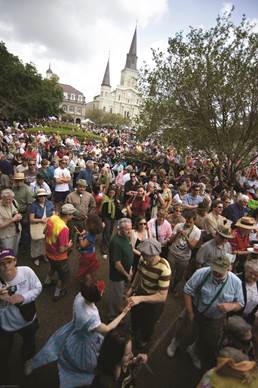We’ve partied our way through Mardi Gras, bad weather and all; dodged the rain drops as we cheered on the Irish and Italians; and sloshed our way through City “Pork” on our way to pick out our favorite barbecue. So we’re owed a little good weather as we wedge our way into the Vieux Carre for the upcoming weekend’s French Quarter Festival.
This “party with a purpose” started out 31 years ago as a way to get locals back into a Quarter tortured by torn-up streets and construction in anticipation of the 1984 World’s Fair. It was the idea of then-Mayor Dutch Morial. And it has certainly worked. Over the three decades it has been in existence, this initially one-year-only street party for New Orleanians has grown into an annual free public event. Last year alone saw more than a half-million people descend on the Quarter over four days, says Marci Schramm, FGFI Executive Director.
Clearly what started out as a party for us has morphed into another major tourist attraction.
“New Orleans’ best-kept secret hasn’t been a secret for years,” says Schramm, explaining that at least 250,000 of the folk at the festival are tourists. “But we work really, really hard to keep our locals happy. We’ve done a lot to make things better; we’ve moved some stages around; we’re spreading things out; we’re trying to make more elbow room.”
 Now, to be clear, a quarter of a million tourists spending money on hotel rooms, restaurants, bars and shopping is a good thing. But what happens to a festival originally created for us, with all this major growth? And what does the city really get out of this?
Now, to be clear, a quarter of a million tourists spending money on hotel rooms, restaurants, bars and shopping is a good thing. But what happens to a festival originally created for us, with all this major growth? And what does the city really get out of this?
“We exist because at the beginning this neighborhood needed economic help,” Schramm says. “This festival was born to contribute to the economic quality of the French Quarter.”
And, says Schramm, it has and continues to make that contribution.
“Last year’s economic impact was $260 million and that is second in the city only to Mardi Gras,” she says.
So go on down and add to the economic impact. And, if you have time and care to share your experience with us, e-mail us at editor@nolavie.com. We’d like to hear from you.
For more information about where the numerous stages are located and the times when the hundreds of local musicians are scheduled to play, go to www.fqfi.org.
 NOLAbeings Multimedia artist Claire Bangser created NOLAbeings as a portrait-based story project that marries...
NOLAbeings Multimedia artist Claire Bangser created NOLAbeings as a portrait-based story project that marries...  Voodoo in New Orleans: Reviving history: New Orleans fortune telling This article takes a deep dive into the history of Voodoo in New Orleans, its hybridization with Catholicism, and its present-day place in the city's culture. The author visits fortune-tellers in the French Quarter, using their guidance as a tool for introspection rather than a deterministic predictor of the future. Through her experiences in New Orleans, the author feels a mystical connection to both the past and the future.
Voodoo in New Orleans: Reviving history: New Orleans fortune telling This article takes a deep dive into the history of Voodoo in New Orleans, its hybridization with Catholicism, and its present-day place in the city's culture. The author visits fortune-tellers in the French Quarter, using their guidance as a tool for introspection rather than a deterministic predictor of the future. Through her experiences in New Orleans, the author feels a mystical connection to both the past and the future. 